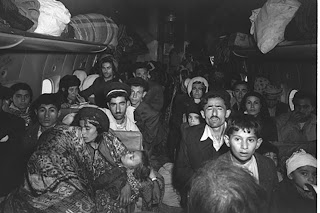
There is still much confusion about the difference between Ashkenazi, Sephardi and Mizrahi Jews. Norman Berdichevsky provides some useful definitions in Heritage Florida Jewish News. (With thanks: Michelle)
Any serious student of Jewish history and tradition knows that the only authentic Sephardim are the descendants of the Jews expelled from Spain and Portugal. They went on to settle in Western Europe including England, Holland, Denmark, North Western Germany, colonial America, the Caribbean and Brazil as well as in lands dominated by Islam, throughout North Africa, the Ottoman Empire, the Balkans and across the Levant. There are thus many Sephardi Jews who have always lived in Europe and many Jewish communities around the world composed of both Sephardim and Ashkenazim, who lived together and intermarried, notably in Italy, Egypt, Syria and Bulgaria, where later Ashkenazi immigrants arrived and were welcome by Sephardi residents. This has also been true in the Caribbean, South America and modern Israel.
Kurdish Jews being airlifted to Israel
Just as America’s Afro-American population has gone through several self-designations indicating a search for their authentic identity ranging from Black to Colored to Negro and then Afro-American and for some, back to Black (originally a term of disparagement used by whites), Israel’s Jews of Afro-Asian origin have shifted from Sephardi to Mizrachi (Oriental). For religious purposes, “Sephardi” describes the nusach (“litugical tradition”) used by most non-Ashkenazi Jews in the Siddur (prayer book).
In reality, there are also many Jews who are neither Ashkenazi nor Sephardi. These include the Jews of Ethiopia, Egypt, India, Iraq, Iran, Yemen, the Caucasus region (Georgia, Azerbaijan, Tajikistan, Uzbekistan, Armenia), all of whom are recognized as being of Afro-Asian origin yet have nothing to do with the original Sephardim. They are the descendants of the Jews who fled into exile following the Assyrian, Babylonian and Roman conquests of ancient Israel. No doubt, they were later joined by numerous converts who were attracted to the high moral and ethical principles that distinguished Judaism in ancient times from pagan and polytheistic religions.
There is indeed a serious social and geo-cultural cleavage in Israel’s diverse Jewish population groups, precisely because all the four divisions overlap to a considerable degree. Most of the Jews from Africa and Asia arrived in Israel after 1948 and being relative newcomers had to adjust to difficult conditions. Most of them arrived destitute and unlike many of the Ashkenazim never received any reparations for their confiscated property.
They still tend to have larger families and as a rule are much more religiously observant than the Ashkenazim who established the secular norms and institutions of the Zionist movement and later of the State of Israel. It is only human nature that the new arrivals from Asia and Africa resented the more established veteran European settlers and those new immigrants from Europe who immediately found more personal connections and sympathy with the veteran Ashkenazi settlers through a common knowledge of Yiddish and shared political and social backgrounds.
A list of new army recruits will probably reveal names like de Leon, Toledano, Castro, Franco, Mizrahi, Dayan, Gabbai, Abulafia, Kimhi, Shar’abi, Sassoon, Azulay, Kadouri, Marziano, Ohana, Aflalo and Hasson, as often or more than Schwartz, Goldberg, Wolf, Guttmann, Rabinowitz, Berdichevsky, Kaplan or Finkelstein. So how then can they then be one people? They are, because history, traditions and their faith (whether they are orthodox observant or secular) have instilled in them the idea of sharing a common peoplehood.

Leave a Reply